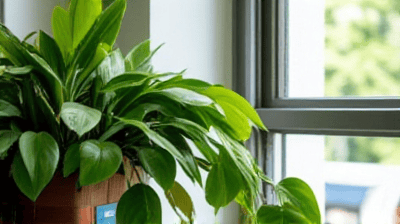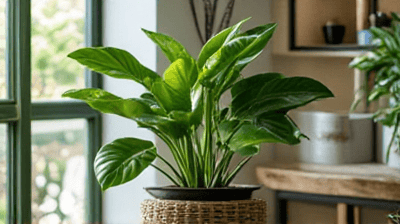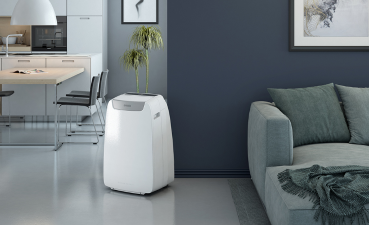In our modern world, where we spend a significant portion of our time indoors, the quality of the air we breathe is more important than ever. Many people are unaware that indoor air can be more polluted than outdoor air due to various factors such as dust, mold, and chemicals from household products. One of the most effective and natural ways to improve indoor air quality is by introducing indoor plants into your living space. These green companions not only enhance your home’s aesthetic appeal but also help purify the air by filtering out toxins and releasing oxygen.

1. Spider Plant (Chlorophytum comosum)
The spider plant is known for its ease of care and air-purifying capabilities. This hardy plant is ideal for beginners and is characterized by its arching leaves and the small plantlets that dangle from the mother plant.
Benefits
- Removes pollutants such as formaldehyde, xylene, and toluene from the air.
- Produces oxygen and enhances humidity, which can alleviate dry skin and respiratory issues.
Care Requirements
- Light: Prefers bright, indirect light but can tolerate low light conditions.
- Water: Allow the soil to dry out between waterings. Water more frequently in the growing season and less in winter.
- Temperature: Thrives in temperatures between 65 and 75 degrees Fahrenheit.
Unique Characteristics
Spider plants are non-toxic to pets, making them a safe choice for households with cats and dogs. They also propagate easily, allowing you to share your plant with friends or create a fuller display.
2. Peace Lily (Spathiphyllum)
The peace lily is not only known for its stunning white flowers but also its impressive air-purifying abilities. This elegant plant can thrive in lower light conditions, making it suitable for various indoor spaces.
Benefits
- Efficiently removes harmful chemicals like ammonia, benzene, formaldehyde, and trichloroethylene.
- Increases humidity in the air, which can improve overall air quality.
Care Requirements
- Light: Prefers low to moderate indirect sunlight. Avoid direct sunlight, as it can scorch the leaves.
- Water: Keep the soil damp but not waterlogged. Water when the top inch of the soil feels dry.
- Temperature: Thrives in temperatures between 65 and 85 degrees Fahrenheit.
Unique Characteristics
The peace lily is moderately toxic to pets if ingested, so it’s important to place it out of reach if you have curious animals. However, with proper care, it can bloom multiple times a year, showcasing its beautiful flowers.

3. Snake Plant (Sansevieria trifasciata)
The snake plant, also known as mother-in-law’s tongue, is famous for its striking linear leaves and hardiness. This plant thrives on neglect, making it perfect for busy individuals.
Benefits
- Known for its ability to remove formaldehyde, xylene, and nitrogen oxides from the air.
- Unique in that it converts carbon dioxide to oxygen at night, improving air quality even while you sleep.
Care Requirements
- Light: Can tolerate low light but grows best in bright, indirect light.
- Water: Allow the soil to dry completely between waterings. Water every couple of weeks, reducing frequency in winter.
- Temperature: Prefers temperatures between 60 and 75 degrees Fahrenheit.
Unique Characteristics
The snake plant is virtually indestructible and can adapt to various indoor environments. Its architectural shape makes it a stylish addition to any room, and it can also help filter indoor air pollutants.
4. Rubber Plant (Ficus elastica)
The rubber plant is a popular indoor choice due to its glossy, large leaves and ability to thrive in a variety of conditions. This plant is not only decorative but also effective at filtering harmful substances from the air.
Benefits
- Excellent at removing formaldehyde and improving indoor air quality.
- Can grow into a striking statement piece in any room.
Care Requirements
- Light: Prefers bright, indirect light but can tolerate low light conditions. However, insufficient light can hinder growth.
- Water: Water when the top inch of soil feels dry. Be cautious not to overwater, as this can lead to root rot.
- Temperature: Thrives at temperatures between 60 and 80 degrees Fahrenheit.
Unique Characteristics
The rubber plant is relatively low maintenance and can grow quite tall, making it a great focal point in a room. Its striking leaves also come in various shades, including deep green and burgundy.
5. Areca Palm (Dypsis lutescens)
The areca palm, also known as the butterfly palm, is an attractive tropical plant that adds a lush, vibrant feel to indoor spaces. This plant is especially popular in larger rooms due to its impressive height.
Benefits
- Known for its ability to filter indoor air pollutants such as formaldehyde, xylene, and toluene.
- Acts as a natural humidifier, helping to maintain moisture in dry indoor environments.
Care Requirements
- Light: Prefers bright, indirect sunlight but can adapt to lower light levels.
- Water: Keep the soil lightly moist but not soggy. Water when the top inch of soil dries out.
- Temperature: Thrives at temperatures between 65 and 75 degrees Fahrenheit.
Unique Characteristics
The areca palm is non-toxic to pets and can grow quite tall, making it an impressive addition to any space. Its feathery fronds create an elegant, tropical atmosphere indoors.
6. Boston Fern (Nephrolepis exaltata)
The Boston fern is a classic houseplant known for its lush, feathery fronds. While this plant may require a bit more maintenance, it is immensely valuable for improving air quality.
Benefits
- Highly effective at removing formaldehyde and other toxins from the air.
- Increases humidity, which can help alleviate dry skin and respiratory issues.
Care Requirements
- Light: Prefers bright, indirect light but can tolerate some shade.
- Water: Keep the soil consistently moist and mist the leaves regularly to maintain humidity levels.
- Temperature: Thrives in temperatures between 60 and 75 degrees Fahrenheit.
Unique Characteristics
The Boston fern is slightly more demanding in terms of care, needing high humidity levels. However, its lush foliage and air-purifying abilities make it well worth the effort. It is also non-toxic to pets.
7. Pothos (Epipremnum aureum)
Pothos, also known as devil’s ivy, is widely regarded as one of the easiest houseplants to grow. Its trailing vines and heart-shaped leaves make it a beautiful addition to any indoor space.
Benefits
- Effective at removing indoor air pollutants such as formaldehyde, benzene, and carbon monoxide.
- Can improve indoor air quality while adding a decorative touch.
Care Requirements
- Light: Tolerates low light but prefers bright, indirect sunlight. Avoid direct sunlight, which can scorch the leaves.
- Water: Allow the top inch of soil to dry out before watering. Water less frequently during the winter months.
- Temperature: Thrives in temperatures between 60 and 85 degrees Fahrenheit.
Unique Characteristics
Pothos is incredibly versatile and can be trained to climb or left to trail from shelves and pots. It is also non-toxic to pets, making it a safe option for households with animals.
8. Dracaena (Dracaena spp.)
Dracaena is a group of plants known for their striking foliage and varied colors. These plants are not only visually appealing but also effective at purifying indoor air.
Benefits
- Removes common indoor air pollutants like formaldehyde, benzene, and trichloroethylene.
- Some varieties, such as Dracaena Marginata, can grow quite tall and serve as statement pieces in a room.
Care Requirements
- Light: Prefers bright, indirect light but can tolerate lower light conditions.
- Water: Water when the top inch of soil becomes dry. Be cautious not to overwater, as Dracaena is susceptible to root rot.
- Temperature: Thrives in temperatures between 65 and 75 degrees Fahrenheit.
Unique Characteristics
Dracaena comes in several varieties, each with distinct leaf shapes and colors. Their unique appearances can complement various interior design styles, making them a favorite among plant enthusiasts.
9. ZZ Plant (Zamioculcas zamiifolia)
The ZZ plant is celebrated for its glossy, dark green leaves and exceptional ability to thrive in low light conditions. This resilient plant is perfect for beginners or those with less-than-perfect indoor environments.
Benefits
- Known to remove pollutants such as xylene, toluene, and benzene from the air.
- Tolerates neglect, making it an excellent choice for busy households.
Care Requirements
- Light: Prefers low to moderate indirect light, but can tolerate low-light environments very well.
- Water: Allow the soil to dry out completely between waterings. Water less frequently in winter.
- Temperature: Thrives in temperatures between 65 and 75 degrees Fahrenheit.
Unique Characteristics
The ZZ plant's ability to survive in low-light and low-water conditions makes it nearly indestructible. Its striking foliage also adds a modern touch to any indoor setting.
10. Bamboo Palm (Chamaedorea seifrizii)
The bamboo palm, also known as the reed palm, is a graceful plant that can add a tropical feel to your home. It is particularly effective at improving air quality.
Benefits
- Removes harmful chemicals like benzene, formaldehyde, and trichloroethylene from the air.
- Acts as a natural humidifier, promoting a more comfortable indoor atmosphere.
Care Requirements
- Light: Prefers bright, indirect light but can adapt to lower light conditions.
- Water: Keep the soil moist but not soggy. Water when the top inch of the soil feels dry.
- Temperature: Thrives in temperatures between 65 and 75 degrees Fahrenheit.
Unique Characteristics
The bamboo palm is pet-friendly and can grow quite tall, making it an attractive focal point in any room. Its feathery fronds create a soothing environment and elevate indoor aesthetics.
Conclusion
Incorporating indoor plants into your home is an effective way to purify the air, reduce stress, and enhance your overall well-being. The benefits of these plants extend beyond just aesthetics; they actively work to remove harmful toxins from the air, increase humidity, and improve air quality, making for a healthier living environment.
By choosing from this list of top indoor plants, you can cultivate a green sanctuary that purifies the air and brings life into your home. Each plant has its unique characteristics and care requirements, so select those that best fit your lifestyle and space. With proper care and attention, these air-purifying plants will thrive in your home and provide you with a breath of fresh air.
Transform your living space today by bringing the beauty of nature indoors. Not only will you enjoy the stunning sights and fragrances of your new green companions, but you will also cultivate a healthier environment for you and your loved ones.



